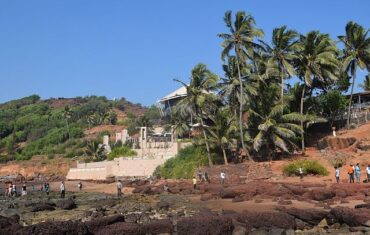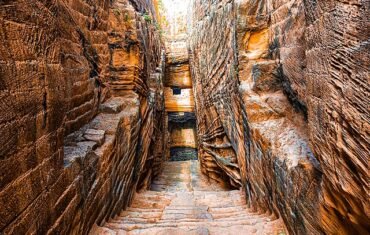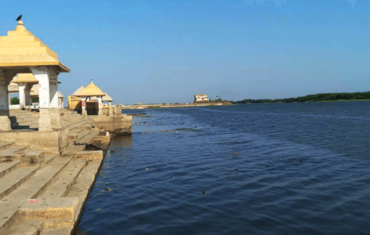Elephanta Caves Mumbai are a collection of cave temples predominantly dedicated to the Hindu god Shiva, which have been designated a UNESCO World Heritage Site. They are on Elephanta Island, or Gharapuri (literally “the city of caves”), in Mumbai Harbour, 10 kilometres (6.2 mi) east of Mumbai in the Indian state of Maharashtra. The caves contain rock-cut stone sculptures and paintings that depict various aspects of Shiva and his consort Parvati, as well as Hindu mythologies and legends. Visit during Mumbai One day Tour.
Distance From City Center Location of Elephanta Caves

The caves are situated about 25 km from the city center of Mumbai. The nearest railway station is Chhatrapati Shivaji Terminus, which is connected to major cities like Delhi, Kolkata, Chennai, and Bangalore. The nearest airport is Chhatrapati Shivaji International Airport, which is about 25 km away.
Timing/Entry Fees of Elephanta Caves
The caves are open daily from 9:00 am to 5:00 pm, except on Mondays when they are closed. The entry fee for Indian nationals is Rs. 40 per person and for foreign nationals is Rs. 600 per person. There is also a fee for photography and videography, which is Rs. 25 and Rs. 100 respectively.
How to reach Elephanta Caves

There are various modes of transport available to reach Elephanta Caves. One can take a bus, taxi, auto-rickshaw, or car from the railway station or the airport. The most convenient and popular way is to take a ferry from the Gateway of India, which is a landmark monument and a tourist attraction in Mumbai. The ferry ride takes about an hour and offers scenic views of the Mumbai skyline and the Arabian Sea. The ferry service operates between 9:00 am and 2:00 pm daily, except on Mondays when the caves are closed.
Things to Do / Must See Elephanta Caves

There are many things to do and see at Elephanta Caves and the island. Some of them are:
- Darshan of Elephanta Caves: The main attraction of the caves is the darshan of the rock-cut sculptures and paintings that adorn the walls and ceilings of the caves. The caves are numbered from 1 to 7 and each cave has a different theme and style. Some of the notable caves are:
- Cave 1: This is the largest and most impressive cave in Elephanta. It is also known as the Great Cave or the Shiva Cave. It has a large hall with four entrances and three porticos. The hall has four rows of pillars that divide it into smaller chambers. The walls and pillars are carved with various forms and manifestations of Shiva, such as Nataraja (Lord of Dance), Ardhanarishvara (Half-man Half-woman), Sadashiva (Three-faced Shiva), Gangadhara (Bearer of Ganga), Kalyanasundara (Marriage of Shiva), Ravana Anugraha (Ravana Shaking Mount Kailash), Andhakasura Vadha (Slaying of Andhaka Demon), etc. The most famous sculpture in this cave is the Trimurti Sadashiva (Three-faced Shiva), which is 5.45 metres (17.9 ft) high and represents Shiva as the creator, preserver, and destroyer of the universe.
- Cave 2: This is a smaller cave that has a shrine with a linga (aniconic symbol of Shiva) at one end and a vestibule at the other end. The vestibule has four pillars with carved panels depicting scenes from Shiva Purana (a Hindu scripture). The panels include Nataraja, Kartikeya (Son of Shiva), Gajantaka (Killing of Elephant Demon), Yogishvara (Lord of Yoga), etc.
- Cave 3: This is another smaller cave that has a similar layout as Cave 2, but with different carvings on the pillars. The panels include Ardhanarishvara, Uma Maheshvara (Shiva with Parvati), Nandi (Bull Vehicle of Shiva), etc.
- Cave 4: This is an unfinished cave that has only two pillars with carvings of Nataraja and Yogishvara.
- Cave 5: This is also an unfinished cave that has only one pillar with carvings of Nataraja and Ardhanarishvara.
- Cave 6: This is a vihara (monastery) cave that has a shrine with a Buddha statue at one end and a hall with cells for monks at the other end. The hall has four pillars with carvings of Buddhist motifs such as lotus flowers, lions, elephants, etc.
- Cave 7: This is another vihara cave that has a similar layout as Cave 6, but with different carvings on the pillars.
- Elephanta Island: This is a small island that covers an area of about 16 sq km (6.2 sq mi) at low tide and about 10 sq km (3.9 sq mi) at high tide. The island has many attractions such as:
- Cannon Hill: This is a hilltop where two old cannons are installed that were used by the Portuguese who occupied the island in the 16th century.
- Stupa Hill: This is another hilltop where two Buddhist stupas (mound-like structures) are located that date back to the 2nd century BCE.
- Elephanta Village: This is a small village on the south side of the island where about 1200 people live. The village has a school, a hospital, a temple, and a museum.
- Elephanta Lake: This is a freshwater lake on the north side of the island that provides water supply to the villagers.
- Elephanta Forest: This is a dense forest that covers most of the island and hosts a variety of flora and fauna.
Significance of Elephanta Caves

Elephanta Caves have a great significance for the history and culture of India. They are one of the finest examples of rock-cut architecture in India and reflect the artistic excellence and religious diversity of ancient India. They also provide evidence of trade and cultural contacts between India and other regions such as Persia, Arabia, Southeast Asia, etc.
Elephanta Caves are also significant for their location and environment. They are situated on an island that offers a serene escape from the hustle and bustle of Mumbai city. They also provide an opportunity for nature lovers and adventure seekers to enjoy various activities such as trekking, boating, fishing, birdwatching, etc.
FAQ’s
Q: What are the timings for Visit?
A: The timings for visit are from 9:00 am to 5:00 pm daily, except on Mondays when they are closed.
Q: What are the entry fees?
A: The entry fees for Indian nationals are Rs. 40 per person and for foreign nationals are Rs. 600 per person. There are also fees for photography and videography, which are Rs. 25 and Rs. 100 respectively.
Q: What are the best time to visit?
A: The best time to visit is during winter (November to February) when the weather is pleasant and dry.
Conclusion
Elephanta Caves Mumbai are a treasure trove of ancient art, culture, and spirituality. They are a place where one can admire the craftsmanship and creativity of our ancestors and learn about their beliefs and values. They are also a place where one can enjoy nature’s beauty and bounty in harmony with wildlife. They are a place worth visiting for anyone who loves history, culture, or nature.












Comments are closed.